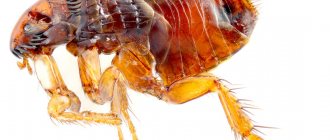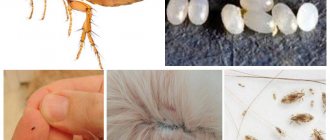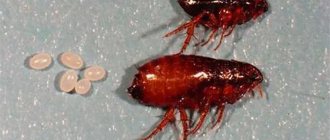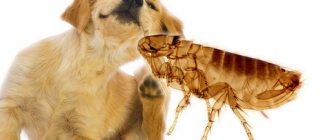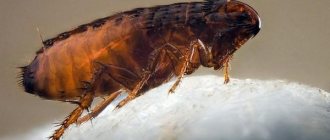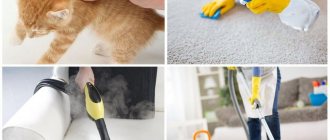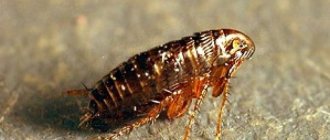- Where do parasites live?
- Why do basement fleas appear in an apartment?
- Why are basement fleas dangerous?
- How to destroy basement fleas in an apartment
- Chemicals for flea control
- Removing basement fleas from animals
- How to kill flea larvae
- Basement treatment
- Traditional methods for fleas in the apartment
- Preventive measures
Basement fleas often appear in city apartments. The likelihood of fleas increases if you have dogs or cats. But, as the name of this type of insect suggests, they live in basements. Let's figure out how to get rid of basement fleas in an apartment building.
Where do parasites live?
It is not difficult to guess which places basement fleas prefer. Basements and crawl spaces are not the only habitat for parasites. Insects choose those rooms whose conditions are favorable for reproduction.
Favorable factors for the existence and reproduction of bedbugs:
- warm room, with air temperature +17, +20 °C;
- high humidity (more than 70%);
- bad light;
- accumulation of garbage, household waste, rags.
Where do basement fleas usually live:
- basements;
- sheds;
- country cellars;
- wells;
- heating mains;
- ground floors.
Often insects appear in the house along with rats running from the basement. They enter the apartment by crawling through cracks and cracks in doors and floors. During the warm season, basement fleas live in dirty, abandoned garbage dumps.
Parasites enter the home not only through animals. People can bring fleas on shoes and clothes after throwing out trash. Fleas that appear in the house begin to lay eggs and actively reproduce.
Insects prefer cozy, secluded places. Also, do not forget that fleas can jump to a height of 1.5 meters.
Where do parasites most often live:
- space under carpets and rugs;
- cabinet corners;
- pet bedding.
Source of appearance in the house
Life cycle of fleas
There are relatively few ways for these harmful arthropods to enter your home. Mostly these methods are associated with living creatures inhabiting the surroundings of the house.
Sources of fleas in the house can be:
Pets
Cats and dogs carry fleas
The most common way for fleas to enter a house or apartment. Cats or dogs are the main carriers of fleas in a person's immediate environment. Actually, if an animal goes out for a walk in warm weather, it will almost always be attacked by fleas.
Fleas, temporarily deprived of a host, climb onto plants or simply tall objects and wait for a living creature to pass by them, after which they jump onto its fur.
Even if the animal is treated with flea treatment, the insect may remain on it for quite a long time before leaving it. Often the process of “leaving” is carried out already in the owner’s apartment.
Items of clothing and footwear
Clothing or shoes can be a source of fleas
Fleas can also travel on the human body. In the end, they may simply make a mistake in determining the type of living creature they have moved onto. The insect will look for a food source for some time, and, not finding it, they will also leave the item of clothing, but who can guarantee that this will be done on the street?
Also, flea eggs from the same animals encountered on the street or somewhere else can get on shoes or clothes.
Utility premises
Rodents living in basements are a source of flea spread
Each house has an attic and a basement, or, in extreme cases, an underground floor. The main carriers of most fleas - rats or mice - can live in such places. With sufficiently large populations of these rodents, there will also be a lot of fleas.
Typically, mass migrations of fleas occur after the death of the carrier, and the mortality rate among mice and rats is quite high. And every day hundreds of insects can lose their owners and go in search of new ones.
The small size of fleas allows them to get into any holes and cracks in walls, doors and floors, thereby appearing in seemingly absolutely incredible places.
Human factor
Fleas are blood-sucking insects
People can also act as carriers of fleas, and not always temporarily. Even wealthy representatives of the species Homo sapiens, who observe the rules of hygiene and carry out flea prevention in their homes, are not immune from becoming their carriers.
Given the small size of insects, as well as their active lifestyle, sometimes even their detection on the human body can occur several days or even weeks after infection.
What can we say about those cases when hygiene rules are not followed. Neighbors are not chosen, and if there is a dysfunctional tenant living in the building whose apartment is infested with fleas due to unsanitary conditions, there is a high probability that about a third of the residents of this building will also get unpleasant “tenants.”
Why do basement fleas appear in an apartment?
The season for basement fleas to appear in an apartment is summer and autumn. Residents of apartments from the first to the third floor and private houses are subject to unpleasant “neighborhood”.
Parasites move into housing:
- from the basement of a residential building (for example, if a person was in it and got fleas on his clothes);
- from neighbors;
- transportation by pets;
- with rodents that have appeared in the home.
Fleas enter the apartment through cracks due to their small size. They live in floor cracks, linoleum, baseboards, and carpet pile.
Another factor in the spread of parasites is the humidity in the basements and sanitary facilities in the apartment is above 60%. Fleas also love warmth. In such conditions, normal life activities are ensured.
How to remove fleas if there is a child in the house
Before removing bloodsuckers using insecticides, you need to make sure that they are safe for a small child. Information of this kind is placed by the manufacturer on the label.
If the product does not pose a danger to the child, then it can be used. Otherwise, the baby will need to be sent to visit his grandmother. It is allowed to return the baby only after a thorough cleaning of the apartment.
Even if the information indicates the safety of an insecticide, in concentrated form it can still cause significant harm to a child. For this reason, the poison should be stored out of reach of the baby.
Why are basement fleas dangerous?
The main food of parasites is blood. Fleas bite painfully, and bite marks become itchy and inflamed. Insects pose a serious danger to people.
What is the danger of basement fleas:
- painful bites that, when scratched, form ulcers and sores;
- the possibility of infection with infectious and fungal diseases, helminths;
- infection of domestic animals with parasites.
If previously fleas parasitized rats, then when they bite a person, they are capable of transmitting terrible diseases to him: plague, hepatitis, typhoid, encephalitis and others. An increase in body temperature is the first sign indicating the onset of an infection.
There is always a possibility that an apartment will be infested with parasites. To reduce the risk of an unpleasant neighborhood, carry out regular preventive maintenance and take timely measures to destroy insects that have already settled.
How to destroy basement fleas in an apartment
To control insects, you must do the following:
- Remove carpets, bedspreads and capes and take them to dry cleaning, or carefully beat them outside.
- Wash the floors, including the baseboards, using a vinegar solution, and then rinse again with detergent.
- Seal floor and window cracks, first treating them with insecticides.
- Treat indoor rooms, floors and walls (1.5 meters from the floor) with special anti-insect preparations.
- Wash bedding and bedding used for animal resting.
- Treat your pets.
Fleas are repelled by odorous plants - eucalyptus, wormwood, tansy and others. Spread the herb around the perimeter of the apartment or prepare a tincture from it. The tincture is used to wipe floors and baseboards. Remember that traditional methods of killing insects are significantly inferior in effectiveness to chemical insecticides.
Mandatory events
Tar soap for fleas
Removing fleas that have become firmly established in an apartment or house is quite problematic, but it is still possible. The difficulties in dealing with them lie, first of all, in their small size, ability to go without food for a long time and very high fertility.
Fleas can literally wait out unpleasant times for months, and then come out of hiding and begin hunting for warm-blooded animals.
Therefore, the most important weapon in the fight against fleas is consistency. Only regular and constant repetition of operations for the prevention and destruction of insects can give a positive result.
It is recommended to carry out regular weekend activities to coincide with other hygiene procedures in the home.
Let's look at the list of activities that need to be carried out regularly to combat fleas:
Pet treatment
Applying flea drops to the dog's withers
Actually, this is where it all begins. The dog or cat should be washed with anti-flea shampoo and treat the animal's skin with a special anti-flea product (for example, drops).
The next stage is that all objects and things with which the animal constantly comes into contact should be put into a washing machine and washed at a temperature of at least +60°C.
These things may include:
- sheets and blankets
- pet bed
- his pillows and toys
Those items that are too large in size must first be dried in the Sun and treated using a steam generator or any type of cleaning. As a last resort, simply immerse it in a large container of water in which anti-flea shampoo is dissolved (for example, a bathtub).
If your pet has fleas, there is a high chance that he is also infected with parasites, since insects carry a significant number of helminths. In any case, it is recommended to consult a veterinarian for advice and possible treatment of the animal.
Processing of interior items
Carpet treatment
Carpets and furniture in the apartment must be cleaned. Fleas can be found in a fairly small space - no more than 1 m from the floor, therefore, everything that enters this space needs to be cleaned and treated with special means.
These can be various anti-flea drugs - powders or aerosols.
The following interior items are subject to treatment:
- carpets on the floor and located in the “risk zone”
- soft upholstery of chairs and sofas
- rugs in front of the front door
- rugs in the toilet and bathroom
First, they are processed using a vacuum cleaner (followed by immediate disposal of the contents of the dust container), then using chemicals.
Mopping floors
Floor disinfection is an essential part of the fight against fleas in the house.
Often fleas not only live in small defects in the flooring, but also leave their eggs there. It is necessary to regularly wash the floors with any antiseptic. These can be either special anti-flea products or a simple solution of bleach in water.
When washing floors, you should also treat baseboards, furniture legs, door openings, etc.
Destruction of potential habitats
Destruction of fleas in the apartment
Various items of clothing, shoes, and interior decoration located in the house may already be hopelessly damaged by fleas and cannot be subject to any type of cleaning or restoration. Such items may include old items stored in closets, mattresses, pillows, etc.
If traces of fleas are found on them, it is better to simply throw away such items without hesitation.
Regular cleaning of street clothes and shoes
Outdoor clothing and shoes can become carriers of fleas, so you should carefully treat them after each walk. Shoes need to be washed, and clothes (at least outer ones) need to be washed more often than usual.
Chemicals for flea control
Basement fleas are resistant to detergents, even with the most “nuclear” composition. To get rid of insects, use insecticides sold in specialized stores.
Aerosol and concentrated preparations are more suitable for killing fleas. The most common insecticides against fleas:
- Battalion commander
- Raptor.
- Dichlorvos.
- Executioner.
- Tetrix.
- Diazonon.
- Cucaracha.
Aerosols are easy to use, but require preliminary preparation of the room. Before using the insecticide, it is recommended to put food in the refrigerator, or hide it together with the dishes under a protective film. Children and animals must be removed from the premises until disinfestation is completed.
To kill blood-sucking insects, you will need to spray an aerosol in the room, after closing the windows. Pay special attention to floors, pile coverings, and baseboards. You will need to leave the treated apartment for 1-2 hours. After the allotted time, the apartment is thoroughly ventilated and wet cleaned.
It is recommended to carry out such disinfestation 3-4 times, at intervals of a week. If the eggs and larvae have not been destroyed, regular treatment will help get rid of hatched parasites.
Concentrated products are available in the form of gels or powders and are pre-diluted with water, according to the instructions. The diluted drug is poured into a spray bottle and sprayed around the room.
When using concentrates, be sure to wear protective clothing, gloves, goggles and a respirator. Such products are very toxic and pose a danger to people who are not prepared for the process. After finishing the treatment, leave the apartment for at least 3 hours, and upon returning, clean and ventilate the room.
Folk remedies against fleas
Folk remedies against fleas
Despite the abundance of chemicals, a large number of people do not use them very often, and the reason for this is understandable. Whatever the manufacturer’s assurances about the safety of a particular product, they are all poisons to varying degrees and can cause, if not poisoning, then quite serious allergic reactions.
An alternative to the use of chemicals is the use of folk remedies that have been proven for centuries. Undoubtedly, their effectiveness in the medium term is somewhat lower than specialized drugs, but their negative effects have practically no consequences for human health.
Most of these products are of plant origin. Let's take a closer look at folk remedies against fleas.
Sagebrush
Wormwood is a natural flea repellent
One of the most common plants used against fleas. Wormwood contains aromatic oils that have a pungent odor that repels fleas and other insects.
Dried wormwood is laid out in places where fleas may enter or live, and often the floor surface is simply covered with it.
Wormwood does not destroy, but simply repels fleas, so its use is more of a preventive nature.
Persian chamomile
Persian chamomile or peretrum contains a natural insecticide
A more effective product that contains natural insecticides – pyrethrins. The stems and leaves of the plant can not only repel, but also kill fleas.
The disadvantages of using Persian chamomile include the fact that in order to effectively kill insects, the material must be sufficient and fresh, since pyrethrins decompose relatively quickly.
The application is similar to the use of wormwood - the stems and leaves are scattered on the floor and remain on it for 24 hours. After a few days the process is repeated.
Application of infusions
Wormwood to fight parasites
Infusions and decoctions of several components, which have both a repellent and insecticidal effect, have proven themselves well.
For example, concentrated infusions consisting of the following plants work well against fleas:
- wormwood
- eucalyptus
- tansy
- mint
Mixtures of several infusions are also often used. Decoctions and infusions made from pine sawdust have a good repellent effect.
The use of such products consists of treating all surfaces in the apartment located at a height of no more than 1 m from the floor. The treatment is repeated every 2-3 days.
Removing basement fleas from animals
Treating the premises is not enough to completely eliminate the infestation. If pets live in the apartment, they should also be treated with special means.
Preparations used to remove fleas from animals:
- Anti-flea shampoo. Easy to use but effective. You will need to wash the animal with shampoo and repeat this procedure 3 more times until the insects are completely destroyed.
- Flea drops. You can purchase high-quality drops at a veterinary pharmacy or veterinary clinic. According to the instructions, the drops are placed strictly on the withers so that the pet does not reach the drug with its tongue. To achieve greater effect, drops are used for 2-3 weeks.
- Nitenpyram tablets. Advanced parasite infestation requires immediate and effective treatment. The drug is administered orally and begins to act within an hour. It is important to consult a veterinarian before use, as this product is dangerous for the animal.
- Anti-flea collar. A common, easy-to-use tool. The main condition is to change the collar every month, or after the time specified in the instructions. Otherwise, the collar loses its properties.
Remember that most pet products are tailored to your pet's weight. For a pet with a small weight or a pet with diseases, choose a less toxic drug. In any case, choose the most gentle and safe products for your pet.
Take advantage of chemical industry products
The lifespan of fleas is short, but they leave multiple offspring, so traditional methods may not be enough. In this case, it is possible to use more aggressive methods of pest control. These are very effective means that can destroy the entire population almost the first time. And yet, in any case, it is recommended to re-disinfect after two weeks.
- Flea sprays . The main advantage of aerosols is the concentration of the substance, which, thanks to its targeted action, kills unwanted insects almost instantly. At the same time, the targeted action can also be attributed to the disadvantages; treating a large area is extremely time-consuming and expensive. However, if the flea habitat is small, then this method is advisable. The room is first cleaned of unnecessary things, after which the aerosol is sprayed on the floor and walls. The basement is closed for one or two days. Given the strong pungent odor, it is recommended to carry out such disinfection using a respirator and gloves.
- Dust and other powder products . Powdered flea repellent differs favorably from aerosols mainly in its lack of odor. This product is scattered on the floor, its effectiveness remains for at least a year. Manufacturers of powder products note that this method is safe for residents and their pets, and temperature and sunlight do not reduce the effectiveness of the drug.
- A more effective way is special smoke bombs . As a result of use, thick smoke is released, which penetrates even the most inaccessible places and thus completely destroys insects. The main condition is that all doors, windows and possible openings are tightly closed. In addition, using this method will help rid the basement not only of fleas, but also of other pests (rats, mice, ants, cockroaches), if any.
Naturally, such thorough treatment requires time and effort, but the measures taken guarantee the complete destruction of the new generation of parasites.
How to kill flea larvae
Fleas lay a lot of larvae, which become a serious problem for apartment owners. Often after treatment, fleas appear in the room again. To prevent this from happening, destroy the larvae at the same time as the adults.
Phenaxin, Clean House dusts, and Pyrethrium powder will help get rid of the larvae. Sprinkle the powder or coat the cracks and corners in the apartment with fine powder.
Dusts and powders are most effective in combating flea larvae, because the larvae feed on organic matter, on the basis of which powder insecticides are made. The larvae, having tasted the dust, die in the shortest possible time.
Such careful processing takes a lot of time, but guarantees a positive result. Young insects will not appear in your apartment.
Use alternative methods
If for some reason all of the listed methods of fighting fleas in the basement do not suit you, then you can use an alternative method.
- Quite new, but very popular and easy to use, ultrasonic flea repellers. These repellers are a small block with a plug for an outlet. The essence of the work: the device emits ultrasound (high-frequency sound), which the human ear cannot hear, but acts as an irritant on insects. This product allows you to get rid of pests within a few days.
Another exotic, but no less effective device is flea traps . They differ in appearance, price, etc., but the essence of the action is the same - these devices attract insects (usually by heat and light), inside the device there is an adhesive layer coated with a flea-killing substance.
Basement treatment
If fleas entered the home from the basement, poison them in the apartment and basement. The pest control service will help resolve the issue. In addition, rodents, the main carriers of fleas, are destroyed in the basement.
First, the basement is thoroughly cleaned. All household garbage and rags are taken out of it. The room is swept out and, if possible, a damp cloth is passed along the walls to clean them.
Then they check the pipes that run in the basement to detect leaks. If there are defects, you will need the help of specialists to carry out repairs.
The basement is treated independently with insecticidal agents in the form of aerosols. The advantage of the drugs is their ease of use and good effect. Treatment is carried out daily for five days.
Then they take a break of ten days and repeat the manipulations. If the apartments on the lower floors are heavily infested with parasites, you will need professional help from exterminators. Only after this do they poison the parasites in the apartment.
For disinfestation of basement non-residential premises, the most powerful and toxic agent is chosen. Suitable drugs are those that are not recommended for use in houses and apartments.
The entire room is sprayed with insecticides - surfaces, cracks, corners. When leaving the room, you should limit the flow of air by tightly closing doors and windows.
How to protect your home from the reappearance of basement fleas?
Residents of private cottages and the lower floors of apartment buildings are most at risk of fleas coming from the basement. Preventive measures will help reduce the likelihood of this event - creating a protective barrier against blood-sucking parasites:
- Treat the baseboard, window and door openings of the apartment with insecticidal protein.
- Install a fine-mesh grille over the ventilation hole and apply a chemical that repels insects.
- Treat the surfaces of the apartment with boric acid.
- The main source of nutrition for young animals is organic waste. Dust will help destroy larvae that have recently emerged from eggs. But it can only be used in non-residential premises to avoid poisoning pets.
To prevent the appearance of blood-sucking fleas in your home, it is necessary to pay attention not only to living quarters, but also to periodically organize inspection and treatment of the basement. If rodents or pipe leaks are found in it, the problem should be corrected as quickly as possible. It is enough to treat the technical premises of an apartment building with insecticides for preventive purposes no more than once every three months. Ventilating the property at night in spring, summer or warm autumn will help reduce the risk of fleas. This will lead to a decrease in temperature, and insects will rush to leave the basement in uncomfortable conditions.
But if you want to be guaranteed to protect your home from basement fleas or destroy blood-sucking insects, it is better to seek help from a professional pest control service. Specialists will draw up a program with the optimal frequency of processing the object, and select an effective and suitable means to combat blood-sucking insects. You can contact the manager for help and advice by phone or email.
Calculator
Traditional methods for fleas in the apartment
To eliminate basement fleas in an apartment, folk remedies are used. The use of herbal infusions with a specific odor is effective.
Ingredients for infusion:
- 1 part eucalyptus;
- 1 part tansy;
- 2 parts wormwood.
The ingredients are poured with boiling water and left for 12 hours. Then the infusion is poured into a spray bottle. The room is sprayed from a bottle. The product is carefully sprayed onto rugs, floor coverings, and wool carpets.
Caucasian chamomile contains pyrethrins, which have a detrimental effect on fleas. For disinfestation, fresh leaves and stems of the plant are used (dry ones are not effective). It is laid out in rooms for several days, after which it is replaced with fresh again.
Pine sawdust helps remove basement fleas. They fill the bedding on which the pet sleeps. Such activities are carried out before the beginning of spring, when fleas are active.
Baking soda and kitchen salt are used in flea treatment. 180 g of components are mixed and the mixture is sprinkled on the carpets. When 8 hours have passed, the apartment is vacuumed. If necessary, repeat the procedure.
Wormwood and pine shavings have a repellent effect. The plant is scattered along the corridor and left for a week.
A solution based on brewer's yeast and garlic is safe for pets and people using folk remedies. To prepare, grind the garlic and add 500 ml of water. 8 g of beer powder is dissolved in the mixture.
The solution is infused for 8 hours and all corners, crevices, and furniture are wiped. The product is suitable for treating pet fur against fleas.
Peppermint is used to get rid of fleas. The fresh plant is scattered throughout the apartment and under the beds. They also scatter the zest of orange, grapefruit, lemon, and tangerine around the house.
A radical way to get rid of parasites is kerosene and turpentine. The product is applied to the habitats of parasites. After contact with the substances, fleas die instantly.
Use folk recipes
There are many traditional methods for disinfecting basements against fleas. The essence of such methods is not so much in killing insects, but in repelling them. And after some time, pests may appear again. Therefore, the use of such methods is effective in the event of a small number of fleas. For our readers, we have selected several of the most accessible methods from among the many popular ones.
One of the most effective methods is to use wormwood . It is laid out in the corners, the fleas cannot stand the smell of this grass and rush to leave the area. If the use of the herb is not suitable for some reason, then wormwood tincture, which can be easily purchased at a pharmacy, will come to your aid. This tincture is diluted with water 1:1. Use this mixture to wash the entire area, including walls, baseboards and corners. In the same way, you can prevent the appearance of pests after chemical or professional disinfection. Branches of coniferous trees also have a similar property.- A mixture of salt and soda . This mixture is poured in different places: on the floor, behind the baseboards, in all hard-to-reach places, as well as on furniture. After several hours, the area must be vacuumed and washed thoroughly. This method works as follows: salt, when it gets on a flea, almost immediately corrodes its body, and soda acts in a similar way. Together, these two products quickly clear the room of insects, and this method is absolutely harmless to people. It is better and more effective if this procedure is repeated after 2-3 weeks.
- Ammonia . Add a few drops of ammonia to the water for washing floors. Walls and floors are washed with this mixture, special attention is paid to baseboards, corners and places behind furniture. Ammonia can be replaced with eucalyptus tincture, the effect will be the same.
Considering the short-term effect of traditional methods of fighting basement fleas, it is necessary to repeat them regularly.
